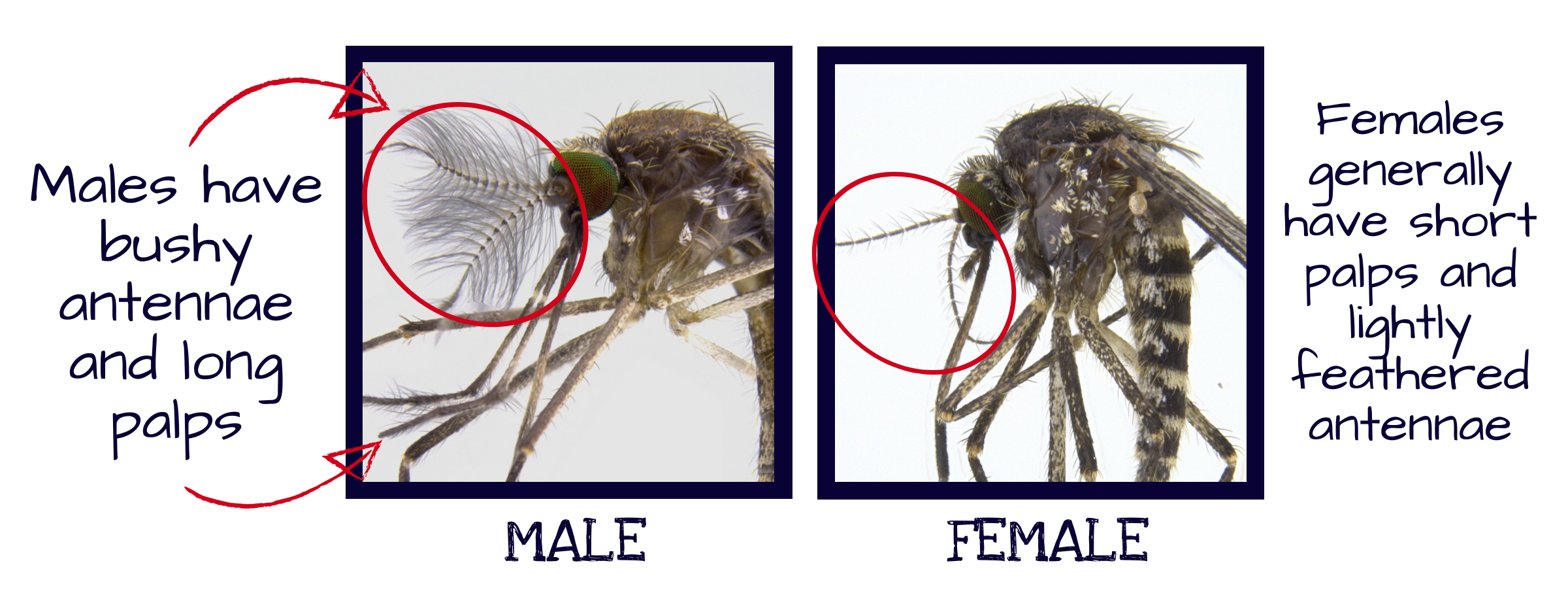Accurate adult mosquito identification plays an important role in determining the species composition of mosquito fauna at a given place and time. It will also help to determine whether significant pest or disease vectors are present, and inform the appropriate mosquito management activities required.
Mosquito identification
Adult mosquitoes (family Culicidae) are slender, fragile, long-legged insects. They need to be differentiated from similar looking insects, including non-biting midges (family Chironomidae) and crane flies (family Tipulidae), which are quite often mistaken for mosquitoes by the inexperienced observer. An adult mosquito has all of the following three characteristics:
- a long proboscis (biting organ) protruding from the head and this proboscis is several times longer than the head itself;
- one pair of wings; and
- scales present on the veins of the wings and a fringe of scales on the hind edge (magnification will be required to see these veins and the scales).
Once an insect has been identified as a mosquito, it is important to determine the species. Region-specific, mosquito identification keys have been developed to allow adult mosquitoes to be identified to the species level on the basis of external characteristics. Variations in body part structure, colour and patterns of markings allow accurate differentiation. Although some distinguishing characteristics may be obvious and tentatively identified with the naked eye, the majority of characters used in adult mosquito identification require examination under at least a x10 hand-lens, but more often a dissecting microscope (x5-x50).
Differentiating mosquitoes from midges
It is important for environmental health staff and pest control operators to be able to differentiate mosquitoes from similar insects, such as midges, both at the larval and adult stages. This is because midges present a nuisance problem only and are not vectors of disease in WA, therefore they do not require management from a public health perspective. Interestingly, the source of 'mosquito complaints' to local government are often due to midges, so it is worthwhile undertaking basic adult trapping to ascertain which insect is present, before management methods are implemented.
The Department of Health has developed a factsheet to assist in differentiating between mosquitoes and midges (PDF 540 KB).
Differentiating male and female mosquitoes
Only female mosquitoes blood feed and serve as disease vectors. It is important to note that identification keys are designed for females, and as such, should not be used to try and identify male mosquitoes. Dry ice-baited traps generally collect females because they are attracted to carbon dioxide. Males will occasionally be trapped if a breeding site is close by. Males can be differentiated from females in a number of ways:
- antennae in males are bushier/hairier than females;
- males have pincer-like claspers (sexual organs) at the end of the abdomen;
- palps on either side of proboscis are long and generally of similar length to the proboscis in males (see diagrams).
Note, some female mosquitoes (e.g. Anopheles species) also have long palps but the antennae are not as heavily ‘feathered’.

Atlas of Mosquitoes of Western Australia
The identification of mosquitoes depends on the recognition of anatomical features in both the larvae and adults. Liehne's Atlas of Mosquitoes of Western Australia (PDF 26MB) provides a useful guide to assist in accurately identifying mosquitoes in both stages.
Region-specific adult mosquito identification keys
Medical Entomology has created a series of region-specific photographic keys to simplify the process of adult mosquito identification in Western Australia (WA). Each key involves a step-wise comparison of particular characteristics, selecting between alternatives and eliminating species when they do not fit the description, until arriving at a conclusion which identifies the species at hand.
The following region-specific photographic keys are available to download and assist in undertaking adult mosquito identification:
Medical Entomology has also developed a region-specific photographic key to assist with identification of larval mosquitoes
Please note, Medical Entomology welcomes feedback on the above photographic keys. All images remain the property of the WA Department of Health and cannot be reproduced or re-used for any purpose without written permission of the State of Western Australia.
While keys provide a rapid means of mosquito identification, they also have a number of limitations. It is important to note that each key is designed for a particular region. If a species from another region, or one collected locally but previously not recorded from the region in question is presented for identification, the key may provide an incorrect identification or possibly none at all. Damaged specimens may be difficult or impossible to key-out if required identifying characteristics are not present. There may also be some natural variation between different populations of the same species within the same region. Finally, it is simply not possible to distinguish between some species (or one sex of some species) on the basis of external appearance alone. In these instances, biochemical or genetic techniques are required to discern between them.
Species identification sheets
A range of A4-sized species identification sheets have also been produced to provide a more detailed explanation of individual mosquito characteristics. Once you have successfully keyed-out an adult mosquito, it may be useful to cross-check it against the relevant species sheet to ensure you have completed this process correctly:
More information
For assistance with mosquito identification, please contact Medical Entomology.
Last reviewed: 21-10-2021